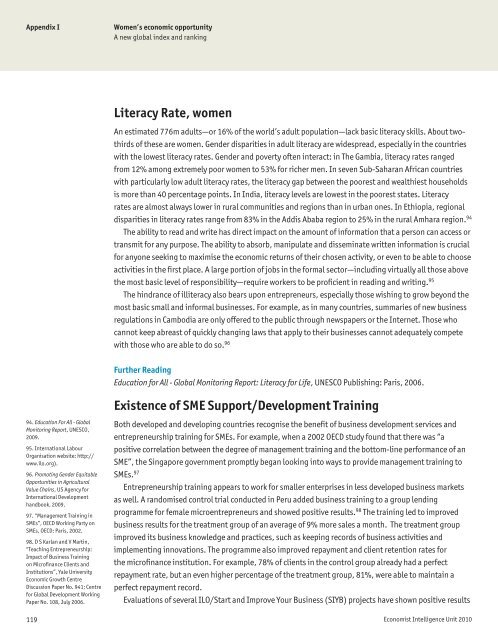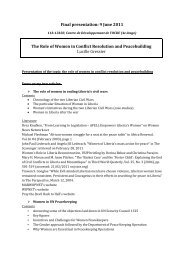Appendix IWomen’s economic opportunityA new global index and rankingLiteracy Rate, womenAn estimated 776m adults—or 16% of the world’s adult population—lack basic literacy skills. About twothirdsof these are women. Gender disparities in adult literacy are widespread, especially in the countrieswith the lowest literacy rates. Gender and poverty often interact: in The Gambia, literacy rates rangedfrom 12% among extremely poor women to 53% for richer men. In seven Sub-Saharan African countrieswith particularly low adult literacy rates, the literacy gap between the poorest and wealthiest householdsis more than 40 percentage points. In India, literacy levels are lowest in the poorest states. Literacyrates are almost always lower in rural communities and regions than in urban ones. In Ethiopia, regionaldisparities in literacy rates range from 83% in the Addis Ababa region to 25% in the rural Amhara region. 94The ability to read and write has direct impact on the amount of information that a person can access ortransmit for any purpose. The ability to absorb, manipulate and disseminate written information is crucialfor anyone seeking to maximise the economic returns of their chosen activity, or even to be able to chooseactivities in the first place. A large portion of jobs in the formal sector—including virtually all those abovethe most basic level of responsibility—require workers to be proficient in reading and writing. 95The hindrance of illiteracy also bears upon entrepreneurs, especially those wishing to grow beyond themost basic small and informal businesses. For example, as in many countries, summaries of new businessregulations in Cambodia are only offered to the public through newspapers or the Internet. Those whocannot keep abreast of quickly changing laws that apply to their businesses cannot adequately competewith those who are able to do so. 96Further ReadingEducation for All - Global Monitoring Report: Literacy for Life, UNESCO Publishing: Paris, 2006.94. Education For All - GlobalMonitoring Report, UNESCO,2009.95. International LabourOrganisation website: http://www.ilo.org).96. Promoting Gender EquitableOpportunities in AgriculturalValue Chains, US Agency forInternational Developmenthandbook, 2009.97. “Management Training inSMEs”, OECD Working Party onSMEs, OECD: Paris, 2002.98. D S Karlan and V Martin,“Teaching Entrepreneurship:Impact of Business Trainingon Microfinance Clients andInstitutions”, Yale University<strong>Economic</strong> Growth CentreDiscussion Paper No. 941; Centrefor Global Development WorkingPaper No. 108, July 2006.Existence of SME Support/Development TrainingBoth developed and developing countries recognise the benefit of business development services andentrepreneurship training for SMEs. For example, when a 2002 OECD study found that there was “apositive correlation between the degree of management training and the bottom-line performance of anSME”, the Singapore government promptly began looking into ways to provide management training toSMEs. 97Entrepreneurship training appears to work for smaller enterprises in less developed business marketsas well. A randomised control trial conducted in Peru added business training to a group lendingprogramme for female microentrepreneurs and showed positive results. 98 The training led to improvedbusiness results for the treatment group of an average of 9% more sales a month. The treatment groupimproved its business knowledge and practices, such as keeping records of business activities andimplementing innovations. The programme also improved repayment and client retention rates forthe microfinance institution. For example, 78% of clients in the control group already had a perfectrepayment rate, but an even higher percentage of the treatment group, 81%, were able to maintain aperfect repayment record.Evaluations of several ILO/Start and Improve Your Business (SIYB) projects have shown positive results119 <strong>Economist</strong> <strong>Intelligence</strong> <strong>Unit</strong> 2010
Appendix IWomen’s economic opportunityA new global index and ranking99. “ILO strategy on promotingwomen’s entrepreneurshipdevelopment,” GB.301/ESP/4,International Labour Organisation:Geneva, March 2008. Figuresextrapolated from ILO/SIYB 1998-2003 “Global Outreach Study: Astudy of the outreach and impactof the Start and Improve YourBusiness Programme worldwide”,commissioned by SIYB GlobalCo-ordinator, International LabourOrganisation, Geneva, 2003; andthe SIYB China Evaluation Report2004-07.100. ibid.101. S D Barwa, “Impact of StartYour Business (SYB) Training onWomen Entrepreneurs in Vietnam”,International Labour Organisation:Geneva, 2003.102. S Carlsson and T T L Anh, “StartYour Own Business Programme,Vietnam Impact Study,”International Labour Organisation:Geneva, 2001.J Voeten, “Management TrainingEffects on Women EntrepreneursWho Own and Manage Micro andSmall Enterprises”, TWMSE2 ProjectWorking Paper, Maastricht Schoolof Management, 2002.103. S Esim, “See How They Grow:Business Development Servicesfor Women’s Business Growth”,International Centre for Researchon Women: Washington DC, 2001.104. L Stevenson, and A St-Onge,Support for Growth-orientedWomen Entrepreneurs in Ethiopia,Kenya and Tanzania, An OverviewReport, International LabourOrganisation: Geneva:, 2005.105. A Morrison and M B Orlando,“The Socioeconomic Costs ofDomestic Violence: Chile andNicaragua”, in Morrison andBiehl (eds.), Too Close to Home:Domestic Violence in the Americas,Inter-American Development Bank:Washington DC, 1999.H Waters, A Hyder, Y Rajkotia, SBasu, J A Rehwinkel, A Butchart,The economic dimensions ofinterpersonal violence, Departmentof Injuries and Violence Prevention,World Health Organisation: Geneva,2004.106. S Lloyd and N Taluc, “Theeffects of male violence on femaleemployment”, Violence AgainstWomen, Vol. 5, No. 4, 1999, pages370-392.F Sánchez et al, “Segunda Parte:Estudio de Mujeres”, in Los costosde la violencia intrafamiliar enColombia, Universidad de losAndes, Centro de Estudios sobreDesarrollo Económico: Bogotá,2004.107. “End Violence AgainstWomen and Girls: The Facts”, UNDevelopment Fund for Women: NewYork, 2010.in terms of creating female employment and improvement in business performance. As of 2008, the SIYBprogramme is estimated to have trained 940,000 potential micro and small entrepreneurs, and created1.2m jobs. 99Impact analysis from the SIYB programme in Sri Lanka indicates that women entrepreneurs trainedin SIYB are more likely to have created new jobs than male participants in the programme. One-quarterof the women entrepreneurs increased employment in their businesses after SIYB training, comparedwith 8% of men. 100 In Vietnam, nearly 97% of the participants of the programme stated that theirbusiness performance had improved considerably, and nearly 49% said that their personal income forprivate consumption had increased. After participating in the programme, 56 business owners (out of258 surveyed) had hired new employees, creating a total of 185 new jobs. 101 Impact studies of the sameproject showed that women who receive training are more ready to adopt business practices that increaseprofits, grow businesses and create jobs. 102Despite these successes, others have argued that some business development services trainingand support programmes to strengthen micro- and small enterprises have been of limited quality,accessibility, and effectiveness, 103 and that few programmes have focused explicitly on building women’sentrepreneurship skills. 104Overall, in constructing this <strong>Index</strong>, the presence of training programs for SMEs was seen as positive.The indicator measures not only the availability of training (the extent to which training is geographicallyavailable), but also its cost (whether it is affordable to the majority of intended beneficiaries), women’saccess to such programmes, timing (to take into account women’s time shared between work, householdand children), and if training is culturally appropriate.Further ReadingOne Woman = One Business. Why Business and Management Education for Women Is Essential to <strong>Economic</strong>Development, International Centre for Research on Women: Washington DC, September 2008.4) Women’s Legal and Social StatusAddressing Violence Against WomenBeyond constituting a human rights violation and causing harm and suffering, violence against womenand girls is associated with measurable losses in economic terms, both on an individual and on anaggregate level. 105 It has a demonstrable negative effect on female earnings and on women’s ability toremain employed, in terms of longer unemployment periods, higher job turnover, lower income, and morehealth issues that negatively affect their job productivity. 106This in turn negatively affects economic growth. Violence against women has enormous direct andindirect costs for survivors, employers and the public sector in terms of health, police, legal and relatedexpenditures, as well as lost wages and productivity. 107 According to a study in Uganda, about 9% of120 <strong>Economist</strong> <strong>Intelligence</strong> <strong>Unit</strong> 2010




